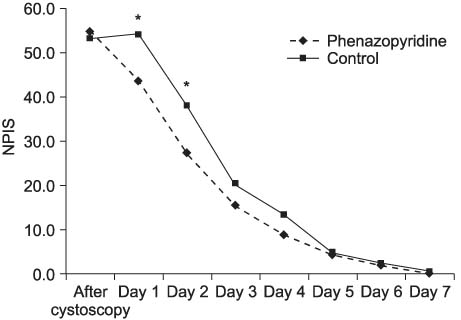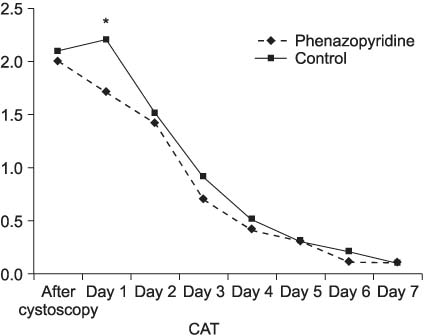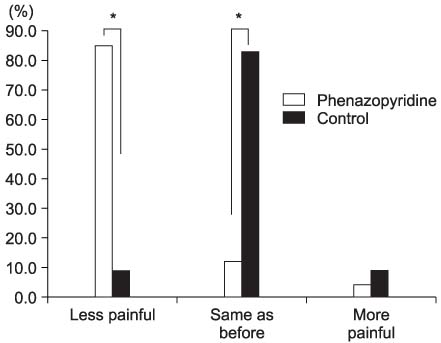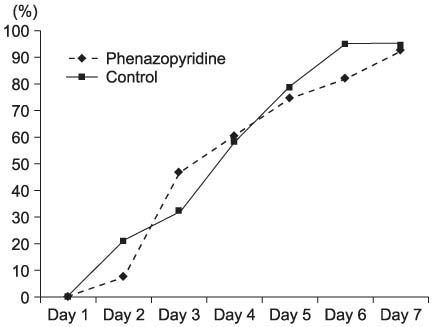Korean J Urol.
2006 Jan;47(1):97-100. 10.4111/kju.2006.47.1.97.
A Randomized, Prospective, Placebo/Controlled Study for the Effect of Phenazopyridine HCl on Pain Perception following Cystoscopy
- Affiliations
-
- 1Department of Urology, College of Medicine, Pusan National University, Busan, Korea. mkchung@pusan.ac.kr
- KMID: 2294223
- DOI: http://doi.org/10.4111/kju.2006.47.1.97
Abstract
-
PURPOSE: This study was designed to evaluate the analgesic effect, the side effects and the safety of using phenazopyridine HCl after cystoscopy, which is a drug that exerts a topical analgesic effect on the mucosa of the urinary tract.
MATERIALS AND METHODS
The 63 patients who underwent cystoscopy at Pusan National University of Hospital from May 2004 to March 2005 were assigned to one of two groups (the experimental group had 35 patients and the control group had 30 patients). The experimental group was administrated antibiotics and phenazopyridine 200mg tid for 4 days and the control group was administrated antibiotics and digestives tid for 4 days. The analgesic effects were assessed with using the Numeric Pain Intensity Scale (NPIS) and the 4-point Categorical scale (CAT).
RESULTS
The mean age of the phenazopyridine and control groups were 62.5+/-8.5 and 60.4+/-10.4 years, respectively, and follow-up period was 7 days. The amount of pain gradually decreased from the day 1 to day 7. The score of the NPIS in the experimental group was less than that of the control group, especially on day 1 and 2 after cystoscopy (p<0.05). The score of the CAT in the experimental group was less than that in the control group, especially on day 1 after cystoscopy (p<0.05). At for the degree of pain for consecutive cystoscopy in the same patients, 22 patients (84.7%) answered it was less painful, 3 (11.5%) answered it was the same as before and 1 (3.8%) answered it was more painful in the experimental group; 2 patient (8.7%) said it was less painful, 19 (82.6%) said it was the same as before and 2 (8.7%) said it was more painful in the control group. Side effects were not observed in all cases.
CONCLUSIONS
We conclude that phenazopyridine HCl is effective for early acute pain relief following cystoscopy without side effects, and it is safe when used in combination with antibiotics.
Keyword
MeSH Terms
Figure
Reference
-
1. Persky L, Davis HS. Xylocaine as a topical anesthetic in urology. J Urol. 1953. 70:552–554.2. Haines JS, Grabstald H. Xylocaine: a new topical anesthetic in urology. J Urol. 1949. 62:901.3. Bryce-Smith R. Topical analgesia for urethra. Br Med J. 1955. 4911:462.4. Senger FL, Zorgniotti AW. Cystoscopic safety: a study of topical anesthesia in diagnostic urology. J Urol. 1954. 72:748–754.5. Pliskin MJ, Kreder KJ, Desmond PM, Dresner ML. Cocaine and lidocaine as topical urethral anesthetics. J Urol. 1989. 141:1117–1119.6. Lee SH, Song YS, Park YH. Utility and safty of midazolam anesthesia during cystoscopy. Korean J Urol. 2002. 43:308–312.7. Gould S. Urinary tract disorders. Clinical comparison of flavoxate and phenazopyridine. Urology. 1975. 5:612–615.8. Ballentine CH. Walsh PC, Retik AB, Vaughan ED, Wein AJ, editors. Instrumentation and endoscopy. Campbell's urology. 1998. 7th ed. Philadelphia: Saunders;159–169.9. Goldfischer ER, Cromie WJ, Karrison TG, Naszkiewicz L, Gerber GS. Randomized, prospective, double-blind study of the effects on pain perception of lidocaine jelly versus plain lubricant during outpatient rigid cystoscopy. J Urol. 1997. 157:90–94.10. Gaines KK. Phenazopyridine hydrochloride: the use and abuse of an old standby for UTI. Urol Nurs. 2004. 24:207–209.11. Rule KA, Biggs AW. Transient renal failure following phenazopyridine overdose. Urology. 1984. 24:178–179.12. Vega J. Acute renal failure caused by phenazopyridine. Rev Med Chil. 2003. 131:541–544.13. Rivas R, Martinez Torres A, Bohorques R, Martinez Albelo I. Acute kidney failure caused by phenazopyridine overdose. Nefrologia. 2001. 21:97–98.14. Nathan DM, Siegel AJ, Bunn HF. Acute methemoglobinemia and hemolytic anemia with phenazopyridine: possible relation to acute renal failure. Arch Intern Med. 1997. 137:1636–1638.15. Crawford SE, Moon AE Jr, Panos TC, Hooks CA. Methemoglobinemia associated with pyridium administration: report of a case. J Am Med Assoc. 1951. 146:24–25.16. Sand RE, Edelmann CM Jr. Pyridium-induced methemoglobinemia: report of a case. J Pediatr. 1961. 58:845–848.17. Greenberg MS, Wong H. Methemoglobinemia and Heinz body hemolytic anemia due to phenazopyridine HCl. N Engl J Med. 1964. 271:431–435.18. Hood JW, Tooth WN. Jaundice caused by phenazopyridine hydrochloride. J Am Med Assoc. 1966. 198:1366–1367.19. Badley BW. Phenazopyridine-induced hepatitis. Br Med J. 1976. 2:850.20. Lacy C, Armstrong L, Lipsy R, Lance L. Drug information handbook. 1994. 2nd ed. Cleveland: Lexicomp;1114–1118.
- Full Text Links
- Actions
-
Cited
- CITED
-
- Close
- Share
- Similar articles
-
- The Effect of Intraurethral 2% Lidocaine Gel as Topical Urethral Anesthetic During Cystoscopy
- The effect of office based flexible and rigid cystoscopy on pain experience in female patients
- A Randomised, Placebo-controlled Trial of the Effects of Preoperative Pregabalin on Pain Intensity and Opioid Consumption following Lumbar Discectomy
- Does Music Have a Calming Effect on Pain and Anxiety in Patients Undergoing Cystoscopy?
- Effects of Heating Therapy on Pain, Anxiety, Physiologic Measures, and Satisfaction in Patients Undergoing Cystoscopy





